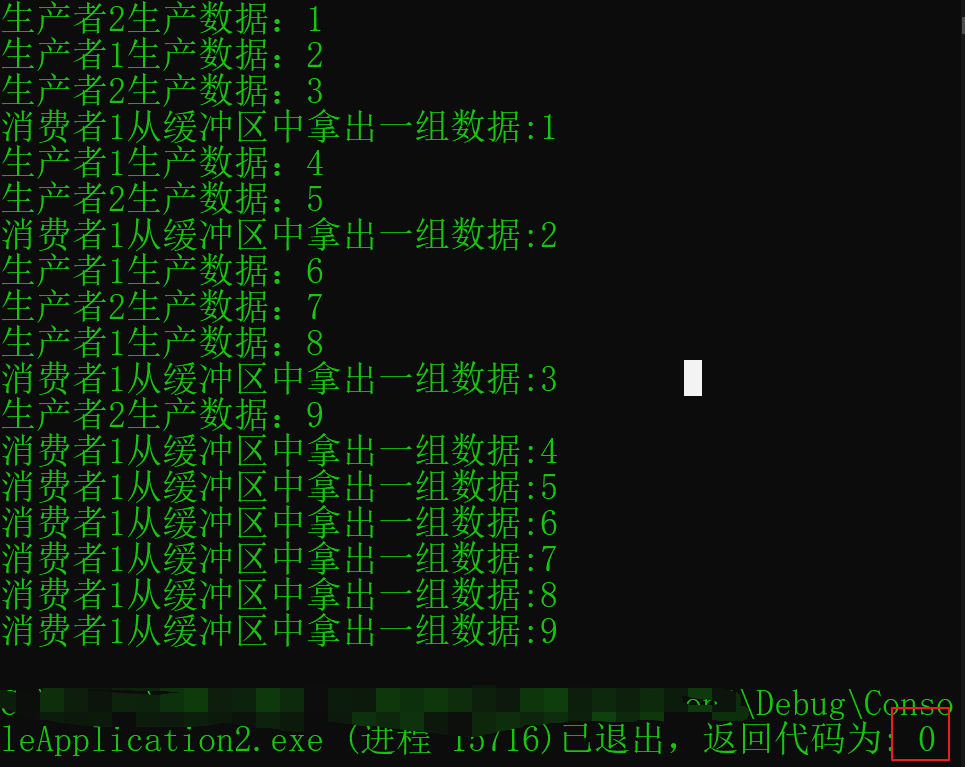再谈多线程模型之生产者消费者(多生产者和单一消费者 )(c++11实现)
0.关于
为缩短篇幅,本系列记录如下:
再谈多线程模型之生产者消费者(基础概念)(c++11实现)
再谈多线程模型之生产者消费者(单一生产者和单一消费者)(c++11实现)
再谈多线程模型之生产者消费者(单一生产者和多消费者)(c++11实现)
再谈多线程模型之生产者消费者(多生产者和单一消费者 )(c++11实现)【本文】
再谈多线程模型之生产者消费者(多生产者和多消费者 )(c++11实现)
再谈多线程模型之生产者消费者(总结)(c++11实现)
本文涉及到的代码演示环境: VS2017
欢迎留言指正
1.多生产者&单一消费者
-
1.1 与 单一生产者和多消费者模型类似, 因为存在多个生产者,需要考虑生产者之间的互斥访问; 消费者只有一个,因此不存在消费者之间的互斥与竞争。
-
1.2 多个生产者, 可能同时放入商品,类比吃水果,父母同时向果盘放入水果,只有子女中的一个吃水果的情况。
-
1.3 具体点
情况 处理 生产者速率 > 消费者速率 消费者只有一个,因此,不存在消费者之间的竞争。生产者存在多个,多个生产者之间生产好数据就需要按照竞争将数据放入缓冲区,谁先拿到锁,谁就先放入。最开始,生产者有多个,只能通过竞争生产。但是由于生产效率大于消费速率, 所以定然会出现商品数量 > 消费者数量。当商品总量达到总数,则需要暂停生产,等待消费者消费 生产者速率 < 消费者速率 最开始,剩余放入总数 > 生产者总数,可以同时放入,随着时间的推移,可能会出现: 剩余放入空间 > 生产者总数 和 剩余放入空间 < 生产者总数。 当出现 剩余空间 < 生产者总数 时,已经不满足同时放入,此时就需要锁。来保证 -
1.4 结构体模型
template<typename T>
struct repo_
{
// 用作互斥访问缓冲区
std::mutex _mtx_queue;
// 缓冲区最大size
unsigned int _count_max_queue_10 = 10;
// 缓冲区
std::queue<T> _queue;
// 缓冲区没有满,通知生产者继续生产
std::condition_variable _cv_queue_not_full;
// 缓冲区不为空,通知消费者继续消费
std::condition_variable _cv_queue_not_empty;
// 用于生产者之间的竞争
std::mutex _mtx_pro;
// 计算当前已经生产了多少数据了
unsigned int _cnt_cur_pro = 0;
repo_(const unsigned int count_max_queue = 10) :_count_max_queue_10(count_max_queue)
, _cnt_cur_con(0)
{
;
}
repo_(const repo_&instance) = delete;
repo_& operator = (const repo_& instance) = delete;
repo_(const repo_&&instance) = delete;
repo_& operator = (const repo_&& instance) = delete;
};
对比单一生产者和单一消费者 可知,仅仅增加了下面的代码
// 用于生产者之间的竞争
std::mutex _mtx_pro;
// 计算当前已经生产了多少数据了
unsigned int _cnt_cur_pro = 0;
- 1.5 生产者线程变化如下
template< typename T >
void thread_pro(const int thread_index, const int count_max_produce, repo<T>* param_repo)
{
if (nullptr == param_repo || NULL == param_repo)
return;
while (true)
{
bool is_running = true;
{
// 用于生产者之间竞争
std::unique_lock<std::mutex> lock(param_repo->_mtx_pro);
// 缓冲区没有满,继续生产
if (param_repo->_cnt_cur_pro < cnt_total_10)
{
thread_produce_item<T>(thread_index, *param_repo, param_repo->_cnt_cur_pro);
++param_repo->_cnt_cur_pro;
}
else
is_running = false;
}
std::this_thread::sleep_for(std::chrono::microseconds(16));
if (!is_running)
break;
}
}
- 1.6 完整源码
#pragma once
#include <iostream>
#include <thread>
#include <mutex>
#include <condition_variable>
#include <queue>
#include <vector>
std::mutex _mtx;
std::condition_variable _cv_not_full;
std::condition_variable _cv_not_empty;
const int max_queue_size_10 = 10;
enum
{
// 总生产数目
cnt_total_10 = 10,
};
template<typename T>
struct repo_
{
// 用作互斥访问缓冲区
std::mutex _mtx_queue;
// 缓冲区最大size
unsigned int _count_max_queue_10 = 10;
// 缓冲区
std::queue<T> _queue;
// 缓冲区没有满,通知生产者继续生产
std::condition_variable _cv_queue_not_full;
// 缓冲区不为空,通知消费者继续消费
std::condition_variable _cv_queue_not_empty;
// 用于生产者之间的竞争
std::mutex _mtx_pro;
// 计算当前已经生产了多少数据了
unsigned int _cnt_cur_pro = 0;
repo_(const unsigned int count_max_queue = 10) :_count_max_queue_10(count_max_queue)
, _cnt_cur_con(0)
{
;
}
repo_(const repo_&instance) = delete;
repo_& operator = (const repo_& instance) = delete;
repo_(const repo_&&instance) = delete;
repo_& operator = (const repo_&& instance) = delete;
};
template <typename T>
using repo = repo_<T>;
//----------------------------------------------------------------------------------------
// 生产者生产数据
template <typename T>
void thread_produce_item(const int &thread_index, repo<T>& param_repo, const T& repo_item)
{
std::unique_lock<std::mutex> lock(param_repo._mtx_queue);
// 1. 生产者只要发现缓冲区没有满, 就继续生产
param_repo._cv_queue_not_full.wait(lock, [&] { return param_repo._queue.size() < param_repo._count_max_queue_10; });
// 2. 将生产好的商品放入缓冲区
param_repo._queue.push(repo_item);
// log to console
std::cout << "生产者" << thread_index << "生产数据:" << repo_item << "\n";
// 3. 通知消费者可以消费了
//param_repo._cv_queue_not_empty.notify_one();
param_repo._cv_queue_not_empty.notify_one();
}
//----------------------------------------------------------------------------------------
// 消费者消费数据
template <typename T>
T thread_consume_item(const int thread_index, repo<T>& param_repo)
{
std::unique_lock<std::mutex> lock(param_repo._mtx_queue);
// 1. 消费者需要等待【缓冲区不为空】的信号
param_repo._cv_queue_not_empty.wait(lock, [&] {return !param_repo._queue.empty(); });
// 2. 拿出数据
T item;
item = param_repo._queue.front();
param_repo._queue.pop();
std::cout << "消费者" << thread_index << "从缓冲区中拿出一组数据:" << item << std::endl;
// 3. 通知生产者,继续生产
param_repo._cv_queue_not_full.notify_one();
return item;
}
//----------------------------------------------------------------------------------------
/**
* @ brief: 生产者线程
* @ thread_index - 线程标识,区分是哪一个线程
* @ count_max_produce - 最大生产次数
* @ param_repo - 缓冲区
* @ return - void
*/
template< typename T >
void thread_pro(const int thread_index, const int count_max_produce, repo<T>* param_repo)
{
if (nullptr == param_repo || NULL == param_repo)
return;
while (true)
{
bool is_running = true;
{
// 用于生产者之间竞争
std::unique_lock<std::mutex> lock(param_repo->_mtx_pro);
// 缓冲区没有满,继续生产
if (param_repo->_cnt_cur_pro < cnt_total_10)
{
thread_produce_item<T>(thread_index, *param_repo, param_repo->_cnt_cur_pro);
++param_repo->_cnt_cur_pro;
}
else
is_running = false;
}
std::this_thread::sleep_for(std::chrono::microseconds(16));
if (!is_running)
break;
}
}
/**
* @ brief: 消费者线程
* @ thread_index - 线程标识,区分线程
* @ param_repo - 缓冲区
* @ return - void
*/
template< typename T >
void thread_con(const int thread_index, repo<T>* param_repo)
{
if (nullptr == param_repo || NULL == param_repo)
return;
static int cnt_cur_con = 0;
while (true)
{
bool is_running = true;
{
// std::unique_lock<std::mutex> lock(param_repo->_mtx_con);
// 还没消费到指定的数目,继续消费
if (cnt_cur_con < cnt_total_10)
{
thread_consume_item<T>(thread_index, *param_repo);
++cnt_cur_con;
}
else
is_running = false;
}
std::this_thread::sleep_for(std::chrono::microseconds(16));
// 结束线程
if ((!is_running))
break;
}
}
// 入口函数
//----------------------------------------------------------------------------------------
int main(int argc, char *argv[], char *env[])
{
// 缓冲区
repo<int> repository;
// 线程池
std::vector<std::thread> vec_thread;
// 生产者
vec_thread.push_back(std::thread(thread_pro<int>, 1, cnt_total_10, &repository));
vec_thread.push_back(std::thread(thread_pro<int>, 2, cnt_total_10, &repository));
// 消费者
vec_thread.push_back(std::thread(thread_con<int>, 1, &repository));
for (auto &item : vec_thread)
{
item.join();
}
return 0;
}
- 1.7 可能结果



 浙公网安备 33010602011771号
浙公网安备 33010602011771号